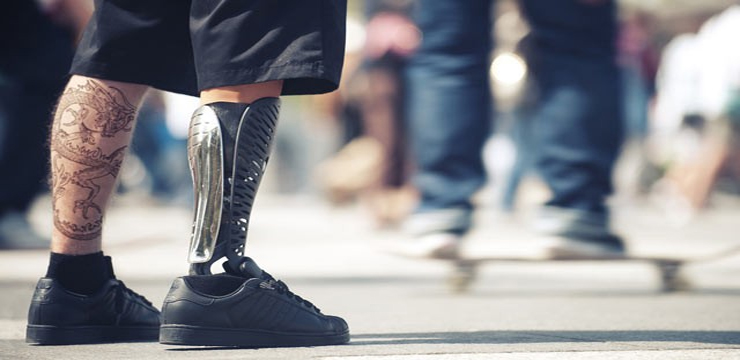Prosthesis (from the Ancient Greek prósthesis meaning “addition,” “application,” or “attachment”) is the practice of creating an artificial limb or body part and integrating it in a fairly permanent way. Prosthetic limbs have been used by mankind for over 3,000 years as a solution to amputation, deformed limbs or body parts from birth, or a number of other physical limitations.
Artificial limbs have come a long way since their beginning; traditionally fashioned from some sort of wood or metal and connected to the body by leather harnesses or straps, prosthetic limbs are moving along with the times and becoming more current in terms of both aesthetics and applications.
Bespoke Innovations and a handful of similar businesses specializing in prosthetic customization have sprung up in the last handful of years. Their goal is to create a look that the wearer likes for their prosthetic limb as it is now a part of their body. Many people with artificial limbs such as Tony Phillips want their limbs to be customized to show a part of themselves instead of a blank, flesh-colored portion of leg.
Many people with artificial limbs realize that it takes a lot for the addition to come close to looking like the body part that it serves as in terms of looking like real flesh, making some come to the conclusion that a custom limb that was artistically made out of metal to look nice and serve its function as well. This newer attitude towards prosthesis, that it can be another form of expression similar to a tattoo, sculpture, or any other personal choice about appearance, has blossomed and is now being catered to by a specific industry for prosthetic limb design and customizing.
Animals too are beginning to avoid the short end of the straw with artificial body parts. From llamas to horses, elephants to dogs, the artificial limb business has grown to accommodate all creatures great and small. For many, this means a second chance entirely.
Roosevelt, a Border Collie born with severely deformed from legs, might have been put down if he hadn’t been adopted. His new owner, Stephanie Fox, made sure that he had a better way of getting around than just relying on his two good legs. She fashioned a sort of wheelchair for him that supported his shoulders and front end with wheels capable of keeping up with the active pup. Roosevelt now enjoys keeping the herding dog pace that was literally bred into him.
Prosthesis, something easily forgotten about in our busy world until it stares us in the face, is rising to be one of the most accommodating influences on a life. Letting dogs run where they would otherwise hobble and humans show off their custom designed limbs like one would show off a tattoo.


Comments are closed.